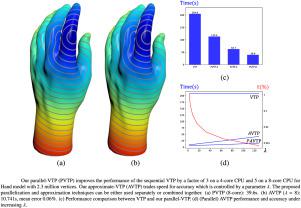Computer-Aided Design ( IF 3.0 ) Pub Date : 2020-09-22 , DOI: 10.1016/j.cad.2020.102943 Jie Du , Ying He , Zheng Fang , Wenlong Meng , Shi-Qing Xin

|
Computing geodesic distances on polyhedral surfaces is a fundamental problem in digital geometry processing and computer-aided design. Most of the existing exact algorithms partition mesh edges into intervals, called windows, and propagate one window at a time. The state-of-the-art, Vertex-oriented Triangle Propagation (VTP), groups the windows on the same half-edge as a window list, and propagates window lists across triangular faces using a vertex-oriented priority queue. VTP runs much faster than the conventional algorithms thanks to its group nature. However, as a sequential algorithm, VTP is still computationally expensive for large-scale meshes. In this paper, we develop a parallel version of VTP, called Parallel-VTP or PVTP, that can propagate multiple window lists from multiple vertices simultaneously. To avoid data conflicts, PVTP proceeds with 3 steps in each iteration, which are -window-list selection, parallel window list propagation, and vertex distance updating and window list merging. Extensive evaluation shows that PVTP improves the speed of the sequential VTP by a factor of 2.53 for and 45 for for triangular meshes with regular tessellation and over 1 million vertices, where is the number of threads.
We observe that wavefront propagation in the exact geodesic algorithms slows down when the wavefront has a long circumference, hereby containing a large number of windows pending processing. To improve the efficiency of window propagation, we develop an approximate variant of VTP, called Approximate VTP or AVTP, which trades speed for accuracy by resetting window when the wavefront radius is a multiple of , where is a user-specified parameter and is average edge length. We show that AVTP becomes Dijkstra’s algorithm when is less than the minimal edge length and becomes the exact VTP when is greater than the longest geodesic distance on the model. AVTP has a theoretical time complexity , which is also confirmed by computational results. It is worth noting that the proposed parallelization and approximation techniques can be either used separately or combined together. Our source code is available at https://github.com/djie-0329/PVTP.
中文翻译:

关于面向顶点的三角传播(VTP)算法:并行化和逼近
在多面体表面上计算测地距离是数字几何处理和计算机辅助设计中的基本问题。大多数现有的精确算法都将网格边缘划分为多个间隔,称为窗口,并一次传播一个窗口。最新的,面向顶点的三角形传播(VTP),将窗口分组在与窗口列表相同的半边沿上,并使用面向顶点的优先级队列在三角形面上传播窗口列表。由于具有分组特性,VTP的运行速度比常规算法快得多。但是,作为顺序算法,VTP对于大规模网格仍然在计算上昂贵。在本文中,我们开发了并行版本的VTP,称为Parallel-VTP或PVTP,它可以同时传播来自多个顶点的多个窗口列表。为避免数据冲突,-窗口列表选择,并行窗口列表传播,顶点距离更新和窗口列表合并。广泛的评估表明,PVTP将顺序VTP的速度提高了2.5倍3个 和45个 用于具有规则镶嵌和超过一百万个顶点的三角形网格,其中 是线程数。
我们观察到,当波前具有长的周长时,精确测地算法中的波前传播会变慢,从而包含大量待处理的窗口。为了提高窗口传播的效率,我们开发了一个近似的VTP变量,称为近似VTP或AVTP,当波前半径是0的倍数时,它通过重置窗口来交换速度以提高准确性。,在哪里 是用户指定的参数,并且 是平均边缘长度。我们证明了AVTP成为Dijkstra的算法时 小于最小边缘长度,并在以下情况下变为精确的VTP 大于模型上的最长测地距离。AVTP具有理论上的时间复杂性,这也得到了计算结果的证实。值得注意的是,建议的并行化和逼近技术可以单独使用,也可以组合在一起使用。我们的源代码位于https://github.com/djie-0329/PVTP。











































 京公网安备 11010802027423号
京公网安备 11010802027423号